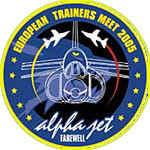European Trainer Meet 2005
Beauvechain, Belgium
15 September 2005

|
European Trainer Meet 2005 Beauvechain, Belgium 15 September 2005
|
|
The third European user of the Alpha Jet is Portugal. This country took over some of the German Alpha Jets during the early nineties to replace the elderly FIAT G.91. The Portuguese Air Force uses the Alpha Jet both as an advanced trainer with Esc 103 and as a light combat aircraft with Esc 301. Both units fly from Beja in southern Portugal. |
|
One of the most popular advanced trainers still in production after some thirty years is the BAE Systems Hawk. This T.1A is from No. 4 FTS, RAF Valley. Like all British training aircraft, the Hawk has been sprayed in an attractive gloss black scheme, making them more conspicious against a grey or blue sky. Lately, this example was followed by the Royal Netherlands Air Force for the Dutch Pilatus PC.7´s. |
|
Ten of these aircraft entered service with the EMVO (Elementary Flying Training School) at Woensdrecht during 1989. Another three were added during the nineties. Originally, the PC.7's were bright yellow with dayglo orange fintip and wingtips, but during the second half of 2005 and the first half of 2006 all will receive a predominantly black colour scheme. L-01 to the right is not yet in it's definitive colour scheme, as it will receive 131 sq's badge on it's fin. |
|
Primary trainers at Beauvechain included for example this French Air Force TB.30 Epsilon from GE 315 at Cognac. Like the British and Dutch trainers, the French Epsilons are also shedding their original bright white and dayglo orange paint schemes. |
|
The Italians however still keep their SIAI Marchetti SF.260AM fleet in an all over dayglo orange scheme. This SF.260 was a very welcome sight at Beauvechain, as Italian primary trainers rarely leave their home country for participation in public events. This particular machine is from Latina's 70° Stormo. |
|
Centre de Instruction Tactique CITac 339 at Luxeuil operates a single Dassault Mystere 20SNR. A modified Dassault Mystere 20 bizz jet, the SNR (Système de Navigation et de Reconnaissance) is used for teaching Mirage F.1CR student pilots using the Mirage's CYRANO IVMR radar system. |
|
Business jets are a very useful starting point for a navigational trainer. This fact was recognised by the RAF some fourty yaers ago already. The Hawker Siddely HS.125 was militarised into the Dominie T.1 and has served the RAF since the mid sixties. Nowadays flying with 3 FTS/ No. 55 (R) sq at RAF Cranwell, the Dominies have also been sprayed black with a white cabin roof. No doubt, this prevents excessive heating of the cabin's interior. |
|
The French Air Force uses the Brazilian EMBRAER EMB.121 Xingu for training aircrew for multi engined aircraft. EAT 319 at Avord is the operating unit. Like the Epsilon and Tucano single engined trainers as well as the Alpha Jets, this Xingu has now also lost it's white and dayglo paint scheme. The French military was the largest customer for this Brazilian design, taking a total of 41 for both the Air Force and the Navy. |
|
The advanced jet trainer with the Italian Air Force was of course also present at Beauvechain. This particular machine is an MB.339A, part of the original batch. During the nineties, the Aeronautica Militare received the improved MB.339CD which also includes the capability of being refuelled in flight. The MB.339A serves with 61° Stormo at Lecce-Galatina. |
|
Although it looks very civil indeed, this Slingsby T.67 Firefly does have a military background. Initial pilot training has been contracted out by the RAF to Babcock Defence Services which maintains these aircraft at RAF Barkston Heath. The Defence Elementary Flying Training School which is the military user of the aircraft consists of 703 Naval Air Squadron and No. 674 sq Army Air Corps, making the school a true multi service unit. Again, the Belgian Air Component provided a very welome opportunity for aviation enthousiasts to visit one of their bases. Many thanks go to the organisers and let's hope for a safe and succesful continuation of the Belgian Alpha Jet's flying career in France. |
All pictures (c) Hans Rolink